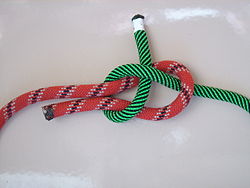Sheet bend
The sheet bend is used for tying two ropes of different thicknesses or rigidity together.
The sheet bend (also known as becket bend, weaver's knot and weaver's hitch) is a bend. It is practical for joining lines of different diameter or rigidity.
It is quick and easy to tie, and is considered so essential it is one of the six knots given in the International Guild of Knot Tyers' Six Knot Challenge, along with the Clove hitch, Bowline, reef knot, round turn and 2 half-hitches, and sheepshank.
The sheet bend is related in structure to the bowline, it has a tendency to work loose when not under load. For increased security, it is sometimes recommended that one add another turn in the smaller end, making a double sheet bend; in most cases, however, a single sheet bend should suffice.
As a bend, its advantages lie in its simplicity and non-jamming properties. It is much more secure and reliable than knots such as the reef knot, which is a binding knot and mistakenly tied as a bend.
To be correct, the two ends should be on the same side of the knot.
 Correct Correct
|
 Incorrect Incorrect
|
Double sheet bend
If the two ropes are very different in thickness, a double sheet bend should be used by adding an extra turn around the thicker rope. The free ends should end up on the same side of the knot for maximum strength.
